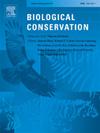Relaxation of management intensity promotes butterfly communities in mountain grasslands
IF 4.9
1区 环境科学与生态学
Q1 BIODIVERSITY CONSERVATION
引用次数: 0
Abstract
Semi-natural mountain grasslands are currently threatened by either land abandonment or management intensification, which calls for evidence-based recommendations for sustainable and biodiversity-friendly farming of these valuable biodiversity hotspots in the long run. We investigated the effects of the relaxation of the management intensity on their plant and butterfly communities, via an experimental reduction of fertiliser inputs. In 2019, 13 study sites were selected in the SW Swiss Alps, each including three meadows that had been intensively managed for at least the previous 20 years. Adopting a randomised block design, two out of three meadows per study site were restored by shifting their mode of exploitation towards low-intensity (1/3 of the fertiliser dose applied beforehand) or extensive management (cessation of fertilisation), respectively, while the third continued to be managed intensively, serving as control. After four years (2023), plant species richness had increased by 9.3 % in extensively managed meadows compared to baseline. Yet, butterfly abundance was more than twice greater (112 %) and species richness 81 % higher in extensively managed meadows compared to controls. A higher butterfly abundance and species richness following management relaxation was mostly driven by a decrease in vegetation density and an increase in forb cover. Extensively managed meadows also exhibited higher conservation values, harbouring comparatively more threatened butterfly species, whilst no change was observed in low-intensity meadows. Altogether these results indicate that the butterfly communities of mountain hay meadow respond rapidly and massively to a relaxation of management intensity.

求助全文
约1分钟内获得全文
求助全文
来源期刊

Biological Conservation
环境科学-环境科学
CiteScore
10.20
自引率
3.40%
发文量
295
审稿时长
61 days
期刊介绍:
Biological Conservation is an international leading journal in the discipline of conservation biology. The journal publishes articles spanning a diverse range of fields that contribute to the biological, sociological, and economic dimensions of conservation and natural resource management. The primary aim of Biological Conservation is the publication of high-quality papers that advance the science and practice of conservation, or which demonstrate the application of conservation principles for natural resource management and policy. Therefore it will be of interest to a broad international readership.
 求助内容:
求助内容: 应助结果提醒方式:
应助结果提醒方式:


